Types of Antennas: Properties, Radiation Patterns and their Working | Electromagnetics - Electronics and Communication Engineering (ECE) PDF Download
Introduction
- In this modern era of wireless communication, many engineers are showing interest to do specialization in communication fields, but this requires basic knowledge of fundamental communication concepts such as types of antennas, electromagnetic radiation, and various phenomena related to propagation, etc.
- In the case of wireless communication systems, antennas play a prominent role as they convert the electronic signals into electromagnetic waves efficiently.
- Antennas are basic components of any electrical circuit as they provide interconnecting links between transmitter and free space or between free space and receiver.
Before we discuss antenna types, there are a few properties that need to be understood. Apart from these properties, we also cover different types of antennas used in a wireless communication system in detail in this document.
What is an Antenna?
- A metallic structure that is used to transmit or capture radio electromagnetic signals is known as an antenna. These are available in different sizes as well as shapes. The small size antennas can be found on the roofs to watch television whereas big ones are used to capturing signals using satellites.
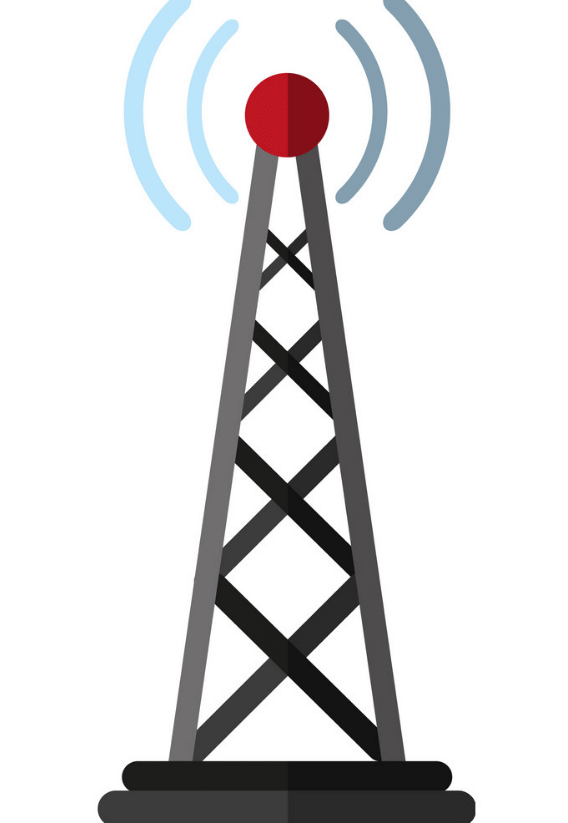 Antenna
Antenna - The antennas that SCaN (Space Communications and Navigation) mainly includes a particular antenna with bowl-shaped that focuses signals at a particular end known as a parabolic antenna. This kind of antenna allows both transmitting and capturing electromagnetic signals which can move vertically and horizontally to transmit and capture the signal.
- From a transmission line, a signal is given to an antenna, after that this signal can be changed into electromagnetic energy to be broadcasted throughout space. Sometimes, an electrical device like an antenna or an aerial is used to change electrical power to electromagnetic signals & vice-versa
- Antenna plays a key role in transmitting receiving electromagnetic radiation.
- In a transmitting antenna, an antenna receives electrical signals from a transmission line & changes them into radio waves. In receiving antenna is quite opposite because it allows radio signals from the space & changes them into electrical signals & provides them to a transmission line. Typical antenna parameters are bandwidth, gain, radiation pattern, polarization, impedance & beamwidth.
Why do we need Antennas?
- There are many reasons to use antennas but the main reason is, they provide an easy method to transmit signals wherever other techniques are not possible.
- For instance, the pilot of an airplane needs to converse with the ATC personnel frequently. So the communication between them can be done through wireless communication & antennas which are the entry for that.
- So, there are several conditions otherwise applications wherever cables are chosen over wireless communication through antennas.
Fundamental Parameters of Types of Antennas
In a wireless communication system, the antenna is an essential component. So the significant thing to know is that the wireless communication system characteristics which depend on the antenna’s characteristics that are used within the system. For instance, the communication system’s operational characteristics will locate back its origins to the antenna’s directional characteristics. In many applications of antennas, antennas are associated with some basic parameters. Sometimes, these are called like characteristics or properties of the antenna. Some of the characteristics of an antenna include the following:
- Radiation Pattern of Antenna
- Polarization of Antenna
- Intensity of Radiation
- Effective Aperture
- Gain & Directivity
- Bandwidth
- Power Gain & Radiation Efficiency
- Effective Length
- Input Impedance
Properties of Types of Antennas
The different properties of types of antennas include the follwoing:- Antenna Gain
- Aperture
- Directivity and bandwidth
- Polarization
- Effective length
- Polar diagram
(i) Antenna Gain: The parameter that measures the degree of directivity of the antenna’s radial pattern is known as gain. An antenna with a higher gain is more effective in its radiation pattern. Antennas are designed in such a way that power raises in the wanted direction and decreases in unwanted directions.
G = (Power radiated by an antenna) / (Power radiated by reference antenna)
(ii) Aperture: This aperture is also known as the effective aperture of the antenna that actively participates in the transmission and reception of electromagnetic waves. The power received by the antenna gets associated with the collective area. This collected area of an antenna is known as effective aperture.
(iii) Directivity and Bandwidth: The directive of an antenna is defined as the measure of concentrated power radiation in a particular direction. It may be considered as the capability of an antenna to direct radiated power in a given direction. It can also be noted as the ratio of the radiation intensity in a given direction to the average radiation intensity. Bandwidth is one of the desired parameters to choose an antenna. It can be defined as the range of frequencies over which an antenna can properly radiate energy and receives energy.
(iv) Polarization: An electromagnetic wave launched from an antenna may be polarized vertically and horizontally. If the wave gets polarized in the vertical direction, then the E vector is vertical and it requires a vertical antenna. If vector E is in a horizontal way, it needs a horizontal antenna to launch it. Sometimes, circular polarization is used, it is a combination of both horizontal and vertical ways.
(v) Effective Length: The effective length is the parameter of antennas that characterizes the efficiency of the antennas in transmitting and receiving electromagnetic waves. Effective length can be defined for both transmitting and receiving antennas. The ratio of EMF at the receiver input to the intensity of the electric field that occurred on the antenna is known as the receivers’ effective length. The effective length of the transmitter can be defined as the length of the free space in a conductor, and current distribution across its length generates the same field intensity in any direction of radiation.
Effective Length = (Area under non-uniform current distrbution)/(Area under uniform current distribution)
(vi) Polar Diagram: The most significant property of an antenna is its radiation pattern or polar diagram. In the case of a transmitting antenna, this is a plot that discusses about the strength of the power field radiated by the antenna in various angular directions as shown in the plot below. A plot can also be obtained for both vertical and horizontal planes – and, it is also named as vertical and horizontal patterns, respectively.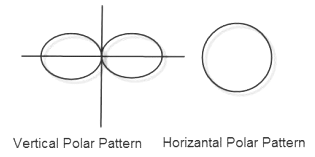
Different Types of Antennas
Till now we have covered the properties of antennas, and now we will discuss different types of antennas that are used for different applications.
1. Log Periodic Antennas
- Bow Tie Antennas
- Log-Periodic Dipole Array
2. Wire Antennas
- Short Dipole Antenna
- Dipole Antenna
- Monopole Antenna
- Loop Antenna
3. Travelling Wave Antennas
- Helical Antennas
- Yagi-Uda Antennas
4. Microwave Antennas
- Rectangular Microstrip Antennas
- Planar Inverted-F Antennas
5. Reflector Antennas
- Corner Reflector
- Parabolic Reflector
Log-Periodic Antennas
- A log-periodic antenna is also named a log-periodic array. It is a multi-element, directional narrow beam antenna that works on a wide range of frequencies.
- This antenna is made of a series of dipoles placed along the antenna axis at different space intervals of time followed by a logarithmic function of frequency.
- A log-periodic antenna is used in a wide range of applications where variable bandwidth is required along with antenna gain and directivity.
 Log Periodic Antenna
Log Periodic Antenna
(i) Bow-Tie Antennas
- A bow-tie antenna is also known as a Biconical antenna or Butterfly antenna.
- Biconical antenna is an omnidirectional wide-band antenna.
- According to the size of this antenna, it has low- frequency response and acts as a high-pass filter.
- As the frequency goes to higher limits, away from the design frequency, the radiation pattern of the antenna gets distorted and spreads.
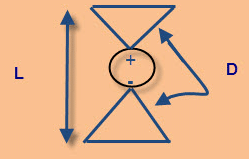 Bow-Tie Antennas
Bow-Tie Antennas - Most of the bow-tie antennas are derivatives of biconical antennas. The discone is a type of half-biconical antenna. The bow-tie antenna is a planar, and therefore, a directional antenna.
(ii) Log-Periodic Dipole Array
- The most common type of antenna used in wireless communication technology is a log-periodic dipole array that fundamentally comprises a number of dipole elements.
- These dipole-array antennas reduce in size from the back end to the front end. The leading beam of this RF antenna comes from the smaller front end.
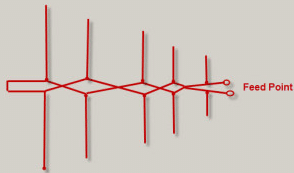 Log Periodic Dipole Array
Log Periodic Dipole Array - The element at the back end of the array is large in size with the half-wavelength operating in a low-frequency range.
- The spacing of the element gets reduced towards the front end of the array wherein the smallest arrays are placed.
- During this operation, as the frequency varies, a smooth transition takes place along the array of the elements, which leads to forming an active region.
Wire Antennas
- Wire antennas are also known as linear or curved antennas. These antennas are very simple, cheap, and are used in a wide range of applications.
- These antennas are further subdivided into four as explained below:
(i) Dipole Antenna
(ii) Short- Dipole Antenna
(iii) Monopole Antenna
(iv) Loop Antenna
 Wire Antenna
Wire Antenna
(i) Dipole Antenna
- A dipole antenna is one of the most straightforward antenna alignments.
- This dipole antenna consists of two thin metal rods with a sinusoidal voltage difference between them.
- The length of the rods is chosen in such a way that they have a quarter length of the wavelength at operational frequencies.
- These antennas are used in designing their own antennas or other antennas. They are very simple to construct and use.
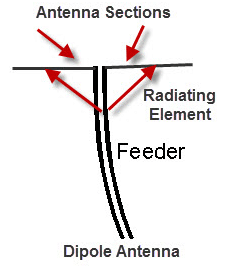
- The dipole antenna consists of two metallic rods through which current and frequency flow. This current and voltage flow makes an electromagnetic wave and the radio signals get radiated.
- The antenna consists of a radiating element that splits the rods and makes current flow through the center by using a feeder at the transmitter out that takes from the receiver.
- The different types of dipole antennas used as RF antennas include half wave, multiple, folded, non-resonant, and so on.
(ii) Short-Dipole Antenna
- It is the simplest of all types of antennas. This antenna is an open-circuited wire in which short denotes “relative to a wavelength” so this antenna gives priority to the size of the wire relative to the wavelength of the frequency of operation.
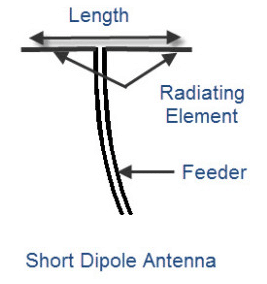
- It does take any consideration about the absolute size of the dipole antenna. The short dipole antenna is made up of two co-linear conductors that are placed end to end, with a small gap between conductors by a feeder. A Dipole is considered short if the length of the radiating element is less than a tenth of the wavelength.

- The short dipole antenna is made of two co-linear conductors that are placed end to end, with a small gap between conductors by a feeder.
- The short dipole antenna is infrequently satisfactory from an efficiency viewpoint because most of the power entering this antenna is dissipated as heat and resistive losses also become gradually high.
(iii) Monopole Antenna
- A monopole antenna is half of a simple dipole antenna located over a grounded plane as shown in the figure below.
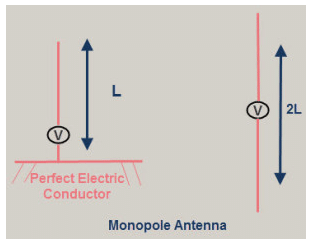
- The radiation pattern above the grounded plane will be the same as the half-wave dipole antenna, however, the total power radiated is half that of a dipole; the field gets radiated only in the upper hemisphere region. The directivity of these antennas becomes double compared to the dipole antennas.
- The monopole antennas are also used as vehicle-mounted antennas as they provide the required ground plane for the antennas mounted above the earth.
(iv) Loop Antenna
- Loop antennas share similar characteristics with both dipole and monopole antennas because they are simple and easy to construct.
- Loop antennas are available in different shapes like circular, elliptical, rectangular, etc. The fundamental characteristics of the loop antenna are independent of its shape.
- They are widely used in communication links with a frequency of around 3 GHz. These antennas can also be used as electromagnetic field probes in microwave bands.
 The circumference of the loop antenna determines the efficiency of the antenna is similar to that of dipole and monopole antennas.
The circumference of the loop antenna determines the efficiency of the antenna is similar to that of dipole and monopole antennas. - These antennas are further classified into two types:
(i) Electrically small
(ii) Electrically large based on the circumference of the loop.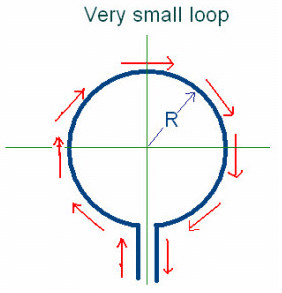
- Due to this, the small loop antenna is mostly used as receiving antennas where losses are not mandatory. Small loops are not used as transmitting antennas due to their low efficiency.
- Resonant loop antennas are relatively large and are directed by the operation of wavelength. They are also known as large loop antennas as they are used at higher frequencies, such as VHF and UHF, wherein their size is convenient.
- They can be viewed as a folded-dipole antenna and deformed into different shapes like spherical, square, etc., and have similar characteristics such as high-radiation efficiency.
Travelling Wave Antennas
These antennas are classified into different types which are discussed below.(i) Helical Antennas
- Helical antennas are also known as helix antennas. They have relatively simple structures with one, two, or more wires each wound to form a helix, usually backed by a ground plane or shaped reflector and driven by an appropriate feed. The most common design is a single wire backed by the ground and fed with a coaxial line.
- In General, the radiation properties of a helical antenna are associated with this specification: the electrical size of the structure, wherein the input impedance is more sensitive to the pitch and wire size.
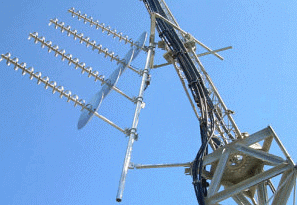 Helical Antenna
Helical Antenna
- Helical antennas have two predominant radiation modes: the normal mode and the axial mode. The axial mode is used in a wide range of applications.
- In the normal mode, the dimensions of the helix are small compared to its wavelength. This antenna acts as the short dipole or monopole antenna.
- In the axial mode, the dimensions of the helix are the same compared to its wavelength. This antenna works as a directional antenna.
(ii) Yagi-Uda Antenna
Another antenna that makes use of passive elements is the Yagi-Uda antenna. This type of antenna is inexpensive and effective. It can be constructed with one or more reflector elements and one or more director elements.
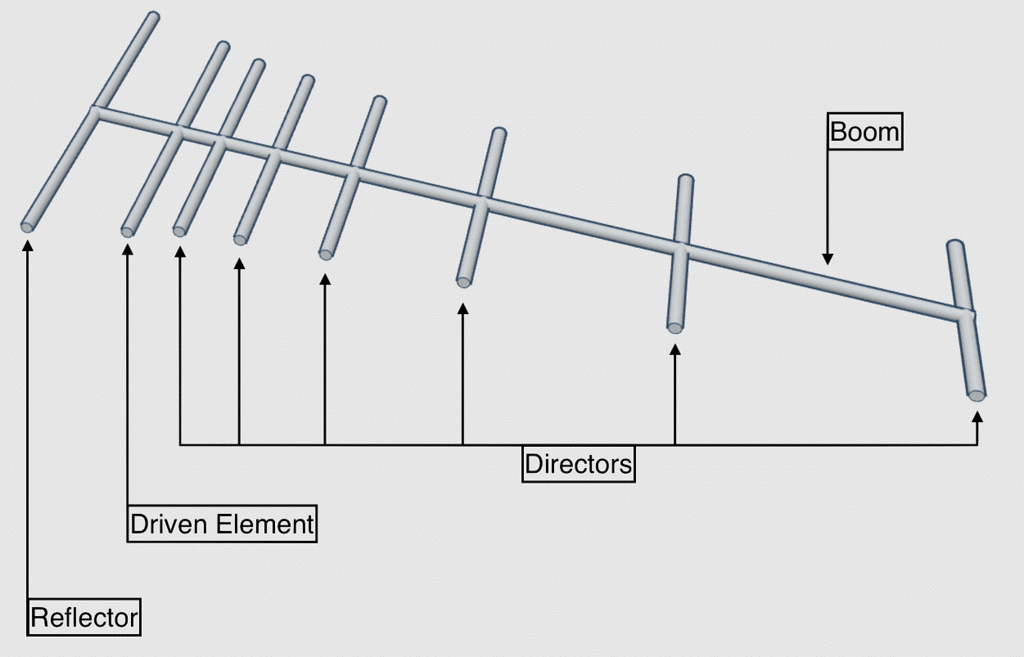 Yagi-Uda Antenna
Yagi-Uda Antenna
Yagi antennas can be made by using an antenna with one reflector, a driven folded-dipole active element, and directors, mounted for horizontal polarization in the forward direction.
Microwave Antennas
The antennas operating at microwave frequencies are known as microwave antennas. These antennas are used in a wide range of applications.(i) Rectangular Microstrip Antennas
- For spacecraft or aircraft applications – based on the specifications such as size, weight, cost, performance, ease of installation, etc. – low profile antennas are preferred.
- These antennas are known as rectangular microstrip antennas or patch antennas; they only require space for the feed line which is normally placed behind the ground plane.
- The major disadvantage of using these antennas is their inefficient and very narrow bandwidth, which is typically a fraction of a percent or, at the most, a few percent.
 Rectangular Microstrip Antenna
Rectangular Microstrip Antenna
(ii) Planar Inverted-F Antennas
- A Planar Inverted-F Antenna can be considered as a type of linear Inverted F antenna (IFA) in which the wire radiating element is replaced by a plate to increase the bandwidth. The advantage of these antennas is that they can be hidden into the housing of the mobile when compared to different types of antennas like a whip, rod, or helical antennas, etc.
- The other advantage is that they can reduce the backward radiation towards the top of the antenna by absorbing power, which enhances the efficiency. They provide high gain in both horizontal and vertical states. This feature is most important for any kind of antennas used in wireless communications.
Reflector Antennas
These antennas are classified into two types which are discussed below.(i) Corner Reflector Antenna
- The antenna that comprises one or more dipole elements placed in front of a corner reflector, is known as a corner-reflector antenna.
- The directivity of an antenna can be increased by using reflectors.
- In the case of a wire antenna, a conducting sheet is used behind the antenna for directing the radiation in the forward direction.
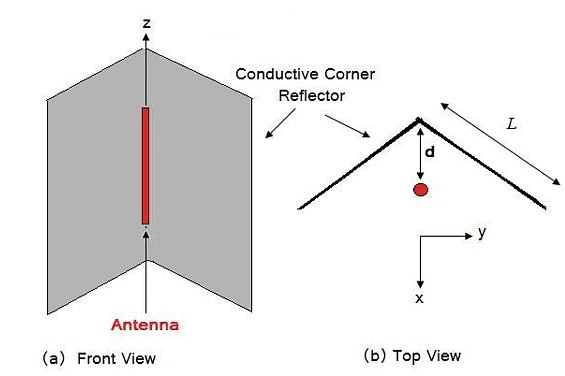 Corner Reflector Antenna
Corner Reflector Antenna
(ii) Parabolic-Reflector Antenna
The radiating surface of a parabolic antenna has very large dimensions compared to its wavelength. The geometrical optics, which depend upon rays and wavefronts, are used to know about certain features of these antennas. Certain important properties of these antennas can be studied by using ray optics, and of other antennas by using electromagnetic field theory.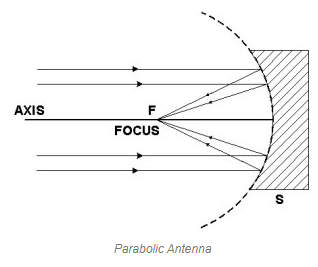 One of the useful properties of this antenna is the conversion of a diverging spherical wavefront into a parallel wavefront that produces a narrow beam of the antenna. The various types of feeds that use this parabolic reflector include horn feeds, Cartesian feeds, and dipole feeds.
One of the useful properties of this antenna is the conversion of a diverging spherical wavefront into a parallel wavefront that produces a narrow beam of the antenna. The various types of feeds that use this parabolic reflector include horn feeds, Cartesian feeds, and dipole feeds.
Types of Antennas used in Satellite Communication
- In satellite communication, antennas play a key role. These are attached to satellites for both transmitting and receiving signals.
- On the satellite, antennas get signals from different sources on Earth. After that, these signals are processed through a transponder & transmitted back to the earth for reallocation.
In a satellite communication system, there are different kinds of antennas that are used which are discussed below.
- Horn Antenna
- Parabolic Reflector Antenna
- Parabolic Reflector Antenna with an offset feed
- Double Reflector Antenna
- Shaped Reflector Antenna
1. Horn Antenna
- A horn antenna is also called a microwave horn that includes a metal waveguide with flaring & horn-shaped to direct radio signals within a ray. Horns are extensively used like antennas at microwave & UHF frequencies over 300 MHz.
- These are used like feed antennas for huge antennas like parabolic antennas and typical calibration antennas for calculating the other antennas gain & directive antennas like radar guns, automatic door openers as well as microwave radiometers. The main benefits of these antennas are low SWR (standing wave ratio), moderate directivity, wide bandwidth & easy construction & adjustment
2. Parabolic Reflector Antenna
- The parabolic reflector antenna is also called a dish antenna. This kind of antenna is used in domestic satellite TV reception, general satellite communications, terrestrial microwave data links, etc. This antenna is identified for its individual shape, high gain & narrow beamwidths.
- The main benefit of this antenna is that it includes high directivity. It works as a flashlight reflector or searchlight to express the radio signals within a narrow ray, otherwise gets radio signals from one specific route only.
- These kinds of antennas are mainly used like high-gain type antennas in point-to-point communications, in microwave relay links that hold TV & telephone signals among near cities, LAN/WAN links for data communications, satellite, spacecraft & radio telescopes.
3. Parabolic Reflector Antenna with Offset Feed
- An off-axis or offset dish antenna is one kind of parabolic antenna because this antenna feed can be offset to the side of the reflector, on the contrary to the ordinary front-feed parabolic antenna wherever the feed antenna can be suspended ahead of the dish. In a front-fed parabolic dish, the feed can be arranged at the central position of the reflector; however the reflector is an asymmetric section of a paraboloid, thus the focus is arranged to the side. It is achievable to utilize different feed arrangements while using this kind of antenna.
- The dissimilar feed arrangements offer a significant amount of flexibility & allow dissimilar applications to achieve the most from the utilization of the antenna. The actual antenna element in the overall parabolic reflector antenna like the device that connects the transmission line with the RF energy toward free space can be the feed element for this antenna. The surface of the reflector is completely passive.
4. Double Reflector Antenna
- By using these types of antennas, the feeder connecting the feed horn toward the transmit or receive equipment should be arranged in less distance to reduce losses.
5. Shaped Reflector Antenna
- In mobile communications, this shaped reflector antenna is used as an outdoor base station antenna. In this antenna, the simple architecture can decrease the cost of implementation & difficulty of a base station antenna. So, the main objective of this antenna is to resemble the necessary radiation characteristics of usual base station antennas, which use antennas with a single‐column phased group to emit directional ray prototypes for radio exposure within cell planning, though enhancing the existing disadvantage of excessively large ray lies on top in contiguous sectors.
- It also rejects the forming of beam circuits for usual base station antennas to decrease the range of passive intermediation. This kind of reflector antenna can be fed through the conventional base station’s elemental antenna, thus it is equipped through the beam tilting functionalities & radiation with dual‐polarization to complete the necessities of adaptive sectorized cell modification.
Types of Antennas used in Mobile Communications
There are two kinds of antennas that are used in mobile communications like rectangular & cellular. These antennas provide different services like rectangular type serves nearby regions, whereas the circular type is used for the communications of inter BTS.
(i) Rectangular Antennas
- Rectangular type antennas are directional which are used for providing the exterior region in the surrounding area of the mobile tower. These kinds of antennas are mainly connected to the BTS using co-axial cables which are used for transmitting or receiving data from the close by mobile phones. Generally, these antennas support all the RF spectrum that is used in different network services like 2G or 3G, or 4G services.
(ii) Circular Antennas
- Circular type antennas are mainly used for communication among different BTSs. These types of antennas work at microwave frequencies & include point-to-point transmission or reception. The connection of these antennas can be done through waveguides which will end at the BTS and from there, the data can be transmitted to nearby areas suing Outdoor antenna Units or IBS.
Radiation Patterns of Different Types of Antennas
- The energy emitted through an antenna can be represented by the antenna’s radiation pattern. These are diagrammatical representations for the radiated energy distribution into space like a function of direction. In the antenna’s radiation pattern diagram, the energy being radiated can be signified through the patterns illustrated in a specific way. In that, arrows signify radiation directions. These patterns are power or field patterns
- The power patterns are designed like a function for the magnitude of different fields. They are designed on logarithmic otherwise usually on a dB scale. The designs of different antennas generate dissimilar radiation patterns and their complexity mainly depends on the design of an antenna.
- The designing of field patterns can be done like a function of different fields. They are designed over a logarithmic scale.
Radiation patterns are available in different types like the following:
- Omni-directional or non-directional pattern
- Pencil-beam
- Fan-beam
- Shaped beam
PYQs: Competitive Exams
Q1: The directivity of an antenna array can be increased by adding more antenna elements, as a larger number of elements [GATE 2015]
(a) Improves the radiation efficiency
(b) Increases the effective area of the antenna
(c) Results in a better impedance matching
(d) Allows more power to be transmitted by the antenna
Ans: b
Q2: Match column A with column B. [GATE 2014]
Column A
1. Point electromagnetic source
2. Dish antenna
3. Yagi-Uda antenna
Column B
P. Highly directional
Q. End fire
R. Isotropic
(a) 1 = P, 2 = Q, 3 = R
(b) 1 = R, 2 = P, 3 = Q
(c) 1 = Q, 2 = P, 3 = R
(d) 1 = R, 2 = Q, 3 = P
Ans: b
Q3: The radiation pattern of an antenna in spherical co-ordinates is given by The directivity of the antenna is [GATE 2012]
The directivity of the antenna is [GATE 2012]
(a) 10 dB
(b) 12.6 dB
(c) 11.5 dB
(d) 18 dB
Ans: b
|
11 videos|94 docs|89 tests
|
FAQs on Types of Antennas: Properties, Radiation Patterns and their Working - Electromagnetics - Electronics and Communication Engineering (ECE)
| 1. What are the different types of antennas used in satellite communication? |  |
| 2. What are the different types of antennas used in mobile communications? |  |
| 3. What are the radiation patterns of different types of antennas? |  |
| 4. What are the properties of different types of antennas? |  |
| 5. How do different types of antennas work? |  |






















